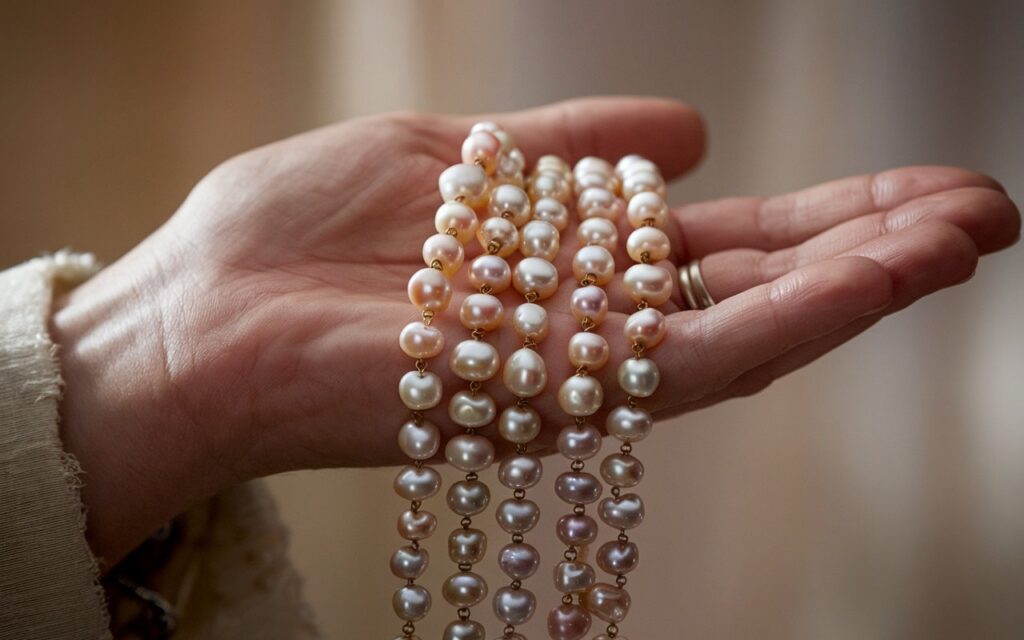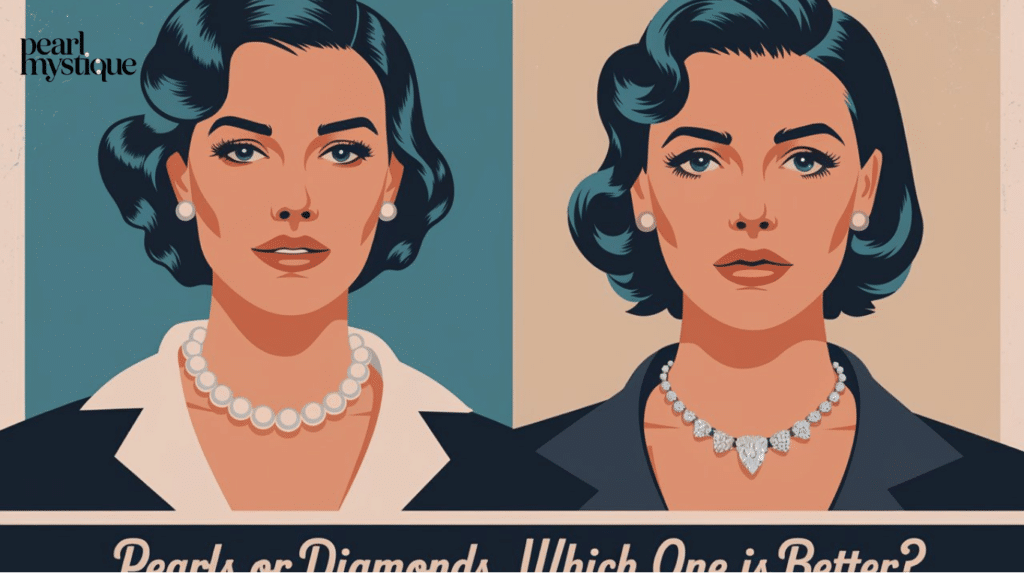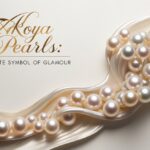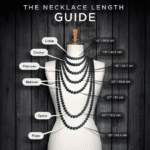Certainly! Here’s a polished version of your article with the key phrase “Diamonds or Pearls? Which gemstone is truly more valuable?” integrated throughout, enhancing readability and engagement while ensuring the keyword density is optimized:
The age-old debate between Diamonds or Pearls? Which gemstone is truly more valuable? has fascinated enthusiasts and collectors for centuries. Both of these gems hold a significant place in history and culture, but when it comes to determining which is truly more valuable, the answer depends on several factors, including origin, rarity, pricing, durability, and symbolism.
In this blog post, we’ll explore these key differences in detail to give you a clear and comprehensive understanding of what makes diamonds and pearls unique and valuable in their own right, and feel free to share your opinion on Diamonds or Pearls? Which gemstone is truly more valuable?
Origin and Formation
Diamonds: Born in the Depths of the Earth
Diamonds are formed through intense geological processes. Buried deep beneath the Earth’s surface, carbon atoms crystallize under extreme pressure and heat to create these precious stones. Diamonds are found in volcanic rock formations known as kimberlite pipes, which bring them closer to the surface through volcanic eruptions.
- Timeframe: Diamonds take anywhere from 1 billion to 3.5 billion years to form.
- Mining locations: Today, most diamonds are mined in South Africa, Russia, and Canada. These regions have become the largest producers of high-quality diamonds.
In contrast, lab-grown diamonds can be produced in a matter of weeks using high-pressure, high-temperature (HPHT) or chemical vapor deposition (CVD) techniques, which mimic natural conditions.

Pearls: Nature’s Living Masterpiece
Pearls are one of the few organic gemstones, formed inside living mollusks like oysters and mussels. When a foreign object such as a grain of sand or parasite enters the mollusk’s shell, the creature responds by secreting layers of nacre, which eventually forms a pearl.
- Natural vs. Cultured Pearls: Natural pearls, which are formed without human intervention, are incredibly rare. Most pearls available today are cultured, meaning humans introduce the irritant to stimulate the pearl-forming process. Cultured pearls account for nearly 99% of the global pearl market.
- Production Areas: Major pearl-producing regions include Japan (famous for Akoya pearls), China (freshwater pearls), and Tahiti (Tahitian pearls).
Fun Fact: Natural pearls are so rare that less than 1 in every 10,000 wild oysters will contain a pearl!
Rarity and Availability
Rarity often influences the question: Diamonds or Pearls? Which gemstone is truly more valuable?
Diamonds: The Illusion of Rarity
While diamonds are often perceived as rare, the truth is more nuanced. Natural diamonds can indeed be rare, particularly colored diamonds such as pink, blue, and yellow diamonds. However, the diamond market is heavily controlled by companies like De Beers, which has historically restricted supply to create an illusion of scarcity.
- Lab-Grown Diamonds: The rise of lab-grown diamonds has further impacted the perceived rarity of diamonds, as these stones can be produced in controlled environments and are chemically identical to natural diamonds.
- Rare Types: Specific diamonds, such as the Hope Diamond or the Pink Star Diamond, can fetch astronomical prices due to their unique characteristics, size, and color.
Pearls: Nature’s True Rarity
Natural pearls are far rarer than diamonds, particularly because of their biological formation process. This rarity is one of the reasons natural pearls are so valuable. However, the advent of pearl farming has made cultured pearls more accessible.
| Gemstone | Natural Formation Process | Rarity | Common Types |
|---|---|---|---|
| Diamonds | Geological (carbon crystallization) | Common | White, colored (blue, pink, yellow) |
| Pearls | Organic (mollusk secretion) | Very rare | Akoya, Freshwater, Tahitian |
Interesting Insight: A large, perfectly round natural pearl can often surpass the value of a large diamond because of its rarity. The famous La Peregrina Pearl was sold for $11.8 million, a testament to pearl value when asking Diamonds or Pearls? Which gemstone is truly more valuable?
You might also like Necklace Length Guide: Crafting A Perfect Look for Any Occasion.
Value and Pricing
Diamonds: The Four Cs
Diamond prices are determined primarily by the Four Cs: Carat, Cut, Clarity, and Color.
- Carat: Refers to the weight of the diamond. Larger diamonds are exponentially more valuable due to their rarity.
- Cut: How well a diamond is cut affects its brilliance and value.
- Clarity: Diamonds with fewer inclusions or imperfections are worth more.
- Color: The less color a diamond has, the higher its value, with D-grade diamonds being the most valuable.
Market Trends: The rise of lab-grown diamonds has affected pricing, as they are typically 30-50% less expensive than their natural counterparts.
Pearls: Pricing by Type
Pearl prices depend on size, luster, shape, and surface quality. Cultured pearls vary widely in price based on the type:
- Akoya Pearls: Known for their brilliant luster, range from $100 to $10,000.
- Tahitian Pearls: Famous for their natural dark colors, prices start around $500 and can reach $20,000.
- South Sea Pearls: Among the largest and rarest, they can command prices upwards of $100,000 for a strand.
Diamonds vs Pearls: Investment Potential
Diamonds are commonly seen as investments, though their resale value can be lower. Natural pearls often retain value better due to scarcity. So, Diamonds or Pearls? Which gemstone is truly more valuable? History shows pearls can hold competitive worth, especially with unique provenance.
Case Study: In 2018, a 14.2-carat diamond sold for $50 million, while the La Peregrina Pearl, a natural pearl with royal history, sold for nearly $12 million, showing that pearls can compete in value with diamonds when they possess unique attributes.
Durability and Wear
Discover Which Gemstone Is Truly More Valuable in the sense of its durability and fragility.

Diamonds: Built to Last
Diamonds rank a solid 10 on the Mohs hardness scale, making them the hardest natural substance. This makes diamonds ideal for everyday wear, especially in engagement rings, which are worn daily.
- Scratch Resistance: Diamonds are highly resistant to scratches, making them low-maintenance and durable over time.
Pearls: Fragile Beauty
Pearls, on the other hand, are much softer, with a Mohs hardness rating between 2.5 and 4.5. They require special care to avoid scratching or damage.
- Care Tips: Pearls should be stored separately from other jewelry to avoid scratching. They also benefit from being worn regularly, as the natural oils from skin help maintain their luster.
| Gemstone | Mohs Hardness | Care Level |
|---|---|---|
| Diamonds | 10 | Low |
| Pearls | 2.5 – 4.5 | High |
Everyday Wear vs. Occasional Use
Diamonds are durable enough for daily wear, especially in rings, bracelets, and earrings. Pearls are more suited to occasional wear, as their softer surface makes them prone to damage over time.
Symbolism and Cultural Significance
Diamonds: Symbols of Strength and Eternal Love
Diamonds have long been associated with strength, clarity, and eternal love. The tradition of using diamonds in engagement rings began in the late 19th century but became widely popular due to De Beers’ famous marketing campaign: “A Diamond is Forever.”
- Modern Symbolism: Today, diamonds are often seen as a symbol of wealth, power, and eternal commitment.
Pearls: Timeless Elegance and Purity
Pearls, in contrast, have been revered for thousands of years as symbols of purity, wisdom, and femininity. They have held special significance in ancient cultures, from the Romans to the Chinese, who viewed pearls as symbols of wealth and status.
- Cultural Significance: Historically, royals and celebrities have adorned themselves with pearls. Famous examples include Queen Elizabeth I and modern icons like Coco Chanel.
Diamonds or Pearls? Which gemstone is truly more valuable? Culturally, both have distinct symbolism that appeals to different personal values.
Quote: “I have often said that I wish I had invented blue jeans: the most spectacular, practical, relaxed, and nonchalant. They have expression, modesty, sex appeal, simplicity—all I hope for in my clothes.” – Coco Chanel, referring to her love for pearls and timeless style.

Personal Preference and Lifestyle
Ultimately, the choice of Diamonds or Pearls? Which gemstone is truly more valuable? depends on lifestyle.
Diamonds: Modern Glamour
Diamonds are often seen as symbols of modern luxury. Their brilliant sparkle and enduring nature make them the gem of choice for those seeking a status symbol.
- Ideal for: People who value durability, luxury, and the enduring tradition of diamonds, especially for engagement rings and heirloom jewelry.
Pearls: Timeless Sophistication
Pearls offer a more understated elegance, ideal for those who appreciate classic beauty and sophistication.
- Versatility: Pearls can be worn with casual or formal attire, making them a versatile choice for many styles.
- Ideal for: Individuals who prioritize sustainability, unique personal style, and a connection to nature’s beauty.
Diamonds: Ethical Challenges and Solutions
The diamond industry has been marred by the controversy of “conflict diamonds”, or “blood diamonds,” which are mined in war zones and sold to finance armed conflict. Efforts like the *Kimberley Process* aim to certify the origin of diamonds and ensure ethical sourcing. However, challenges remain.
- Lab-Grown Diamonds: A growing number of consumers are turning to lab-grown diamonds, which offer a more ethical and environmentally friendly alternative. These diamonds have the same physical and chemical properties as natural diamonds but are produced with significantly less environmental impact.
Pearls: Sustainable Practices
Pearl farming can be conducted in environmentally friendly ways. Responsible pearl farms focus on sustainability, promoting biodiversity and protecting marine ecosystems.
- Sustainable Farming: Many pearl farms engage in practices that support local communities and ecosystems. For instance, some farms grow corals alongside pearls, enhancing marine life and supporting ocean health.
- Certification: Look for certifications indicating sustainable practices, such as the Marine Stewardship Council (MSC), when purchasing pearls.
Conclusion
When it comes to the age-old debate of diamonds vs pearls, the answer isn’t straightforward. Diamonds or Pearls? Which gemstone is truly more valuable? The answer lies in your values and needs. Each gem offers unmatched beauty, heritage, and value, appealing to various lifestyles and tastes.
Key Takeaways:
- Diamonds are celebrated for their durability and association with eternal love, making them a popular choice for engagement rings.
- Pearls stand out for their organic beauty and rarity, with a timeless elegance that appeals to those who prefer classic style.
- The value of both diamonds and pearls varies significantly based on factors such as type, rarity, and market trends.
- Ethical considerations are increasingly influencing consumer choices, with both gemstones offering paths to sustainable and responsible sourcing.
Ultimately, the true value of diamonds and pearls lies in what resonates with you personally. Whether you choose the sparkling allure of a diamond or the soft luster of a pearl, both gems can add beauty and significance to your life.
Call to Action
What are your thoughts on the value of diamonds versus pearls? Do you prefer the timeless elegance of pearls, or are you drawn to the enduring brilliance of diamonds? Share your experiences and preferences in the comments below!
This comprehensive exploration of diamonds vs pearls has aimed to provide you with in-depth knowledge, interesting facts, and useful comparisons to help you understand the complexities of each gemstone. Whether you’re looking to purchase, invest, or simply appreciate these beautiful gems, being informed will enhance your appreciation and decision-making.

Astro Sari is a seasoned blogger with a deep passion for pearls and oceanic gems. With years of experience in the field, he brings insightful knowledge and engaging content to Pearl Mystique. His expertise helps readers explore the beauty, history, and significance of pearls in a captivating way.







